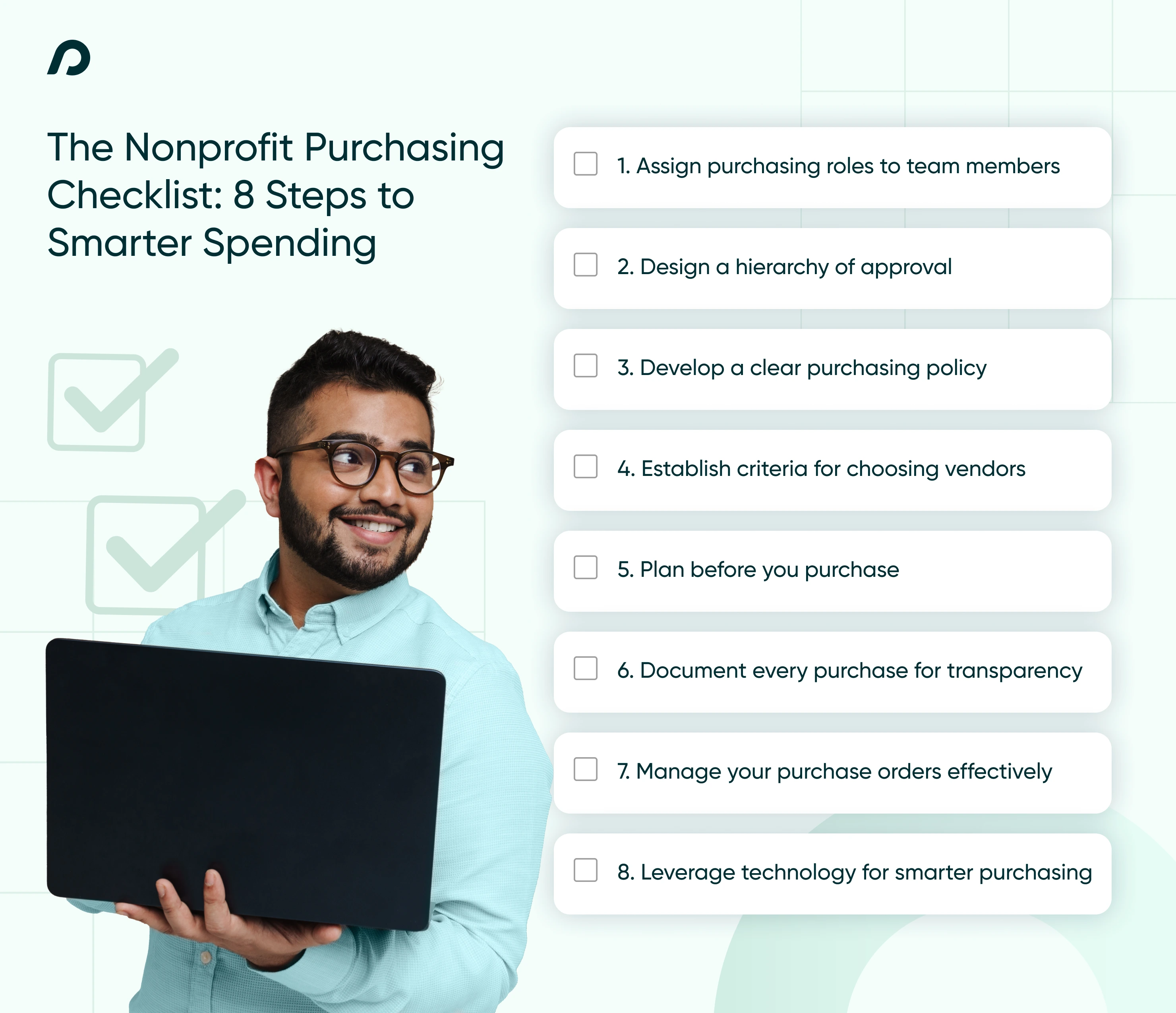
The Nonprofit Purchasing Checklist: 8 Steps to Smarter Spending
For nonprofits, every dollar spent directly affects their ability to serve their mission. Unlike for-profit businesses, nonprofits must navigate tight budgets, donor expectations, and strict financial regulations. Every purchase—whether for office supplies, event materials, or essential services—needs to be intentional, transparent, and cost-effective.
But nonprofit purchasing presents unique challenges: budget constraints that demand every dollar be stretched, the need for transparency to maintain donor and stakeholder trust, and ethical sourcing to align purchases with the organization’s values. Without a structured approach, nonprofits risk overspending, mismanaging funds, or making inefficient purchases.
This checklist offers actionable strategies to help nonprofits streamline purchasing, save money, and make mission-driven decisions.
1. Assign purchasing roles to team members
A lack of clear roles in nonprofit purchasing can lead to unnecessary spending, duplicate purchases, and compliance risks. Assigning specific responsibilities ensures accountability and efficiency. Establishing clear roles within your organization ensures accountability and control.
-
Requesters identify the need for goods or services and submit purchase requests.
-
Approvers review and authorize purchases based on budget and necessity.
-
Finance teams oversee spending, ensure compliance, and process payments.
-
Procurement managers (if applicable) negotiate with vendors and secure cost-effective deals.
To enhance oversight, implement spending thresholds and approval workflows, ensuring that purchases meet financial policies before moving forward.
2. Design a hierarchy of approval
A well-defined approval workflow prevents unauthorized spending and ensures financial accountability. Structuring approval levels by purchase amount helps maintain control without unnecessary delays.
-
Small purchases under $500 can be approved by department heads.
-
Mid-range purchases between $500–$1,000 require finance team approval.
-
Larger purchases over $1,000 need executive or board-level authorization.
Purchasing software like Procurify automates approval workflows, allowing nonprofits to set custom approval tiers, track requests, and maintain financial transparency.
3. Develop a clear purchasing policy
Any nonprofit that receives outside funding is subject to strict regulatory and compliance procedures. After all, you’re tasked with spending money that isn’t your own on things that will directly benefit society.
As part of this regulation, you require an in-depth spend policy that outlines things like:
-
Your micro-purchase method: This outlines the purchase of supplies or services using simplified acquisition procedures, the aggregate amount of which does not exceed the micro-purchase threshold.
-
Small purchase procedures: This outlines the procedures for relatively simple and informal purchases.
-
Sealed bid method: The outlines the method for discrete fair division, allowing for the division of items that cannot be split into smaller pieces, like a house or a car.
-
Competitive proposal method: This outlines the purchasing method where all proposals are reviewed at a predetermined time and place and a contract is awarded in accordance with the terms of a solicitation.
-
Non-competitive proposal method: This outlines the method where the buyer either selects one organization to provide goods and services to, or invites certain suppliers to bid.
On top of these requirements, your nonprofit spend policy should also document how you manage and maintain spend internally. Outline things like your approval hierarchy, type of spend culture, how you manage expenses, and so on.
4. Establish criteria for choosing vendors
All nonprofits should establish a strict set of criteria their vendors must adhere to. For instance, nonprofit vendors should adequately address environmental concerns that come with supply and demand. Another example is manufacturing standards – those manufacturing goods on behalf of a nonprofit should do so in an ethical way.
When evaluating vendors, nonprofits should look for:
-
Cost-effectiveness – Compare vendor pricing and negotiate nonprofit discounts.
-
Reliability – Work with vendors known for timely deliveries and consistent service.
-
Mission alignment – Prioritize ethical and sustainable business practices that support the nonprofit’s values.
-
Nonprofit-friendly offerings – Some vendors provide specialized discounts, grants, or bulk purchasing options tailored for nonprofits.
-
Reputation and references – Seek vendors with positive reviews, strong recommendations, and a proven track record with other nonprofits.
Put together a checklist, canvas the market and shop around. The more information you have about potential vendors, the better.
5. Plan before you purchase
Strategic purchasing helps nonprofits avoid last-minute expenses that could drain resources. Reviewing past expenses helps identify recurring needs, while consolidating orders allows organizations to negotiate better bulk pricing. Planning ahead for fundraising events, seasonal initiatives, and major projects ensures that spending remains controlled and aligned with financial goals.
For example, a nonprofit hosting an annual gala can reduce costs by securing vendor quotes in advance, ordering supplies in bulk, and leveraging nonprofit discounts for marketing materials. By preparing well in advance, organizations not only reduce expenses but also ensure smoother event execution.

6. Document every purchase for transparency
Accurate record-keeping is critical for audits, financial reporting, and donor accountability. Keeping track of every transaction ensures compliance and prevents discrepancies that could lead to financial mismanagement. Receipts and invoices should be stored digitally for easy access and regularly reviewed to maintain transparency.
Using expense management tools like Procurify simplifies tracking purchases, maintaining approval records, and ensuring compliance with grant and donor requirements. Proper documentation also provides insights into spending patterns, helping nonprofits refine their purchasing strategies over time.
7. Manage your purchase orders effectively
Purchase orders (POs) help nonprofits maintain budget discipline by ensuring purchases are pre-approved and accurately tracked. Before making a purchase, organizations should verify that the item is necessary and ensure that multiple approvals are in place for larger expenses.
Automating the PO process with procurement software can reduce manual errors, improve order tracking, and provide clear financial oversight. By maintaining organized records of all POs and their fulfillment, nonprofits can ensure accountability and prevent unnecessary spending.
8. Leverage technology for smarter purchasing
Technology can significantly enhance the efficiency of nonprofit procurement. Automated purchasing workflows help reduce administrative overhead, while real-time budget tracking ensures spending stays within limits. Vendor management tools also help nonprofits maintain a database of reliable suppliers and track contract performance over time.
By implementing Procurify or similar procurement platforms, nonprofits can streamline their purchasing processes, improve approval workflows, and reduce inefficiencies. Digital procurement solutions allow organizations to maintain control over spending, reduce paperwork, and ensure compliance with funding requirements.
Final thoughts: Strengthening your nonprofit’s financial strategy
Nonprofits can stretch their budgets further by taking a structured, strategic approach to purchasing. Assigning clear roles, implementing approval workflows, developing a purchasing policy, and leveraging technology help organizations achieve greater cost savings, maintain financial transparency, and align spending with their mission.
A well-managed purchasing process doesn’t just prevent waste—it empowers nonprofits to do more with every dollar, ensuring resources are directed toward impact rather than inefficiencies.
